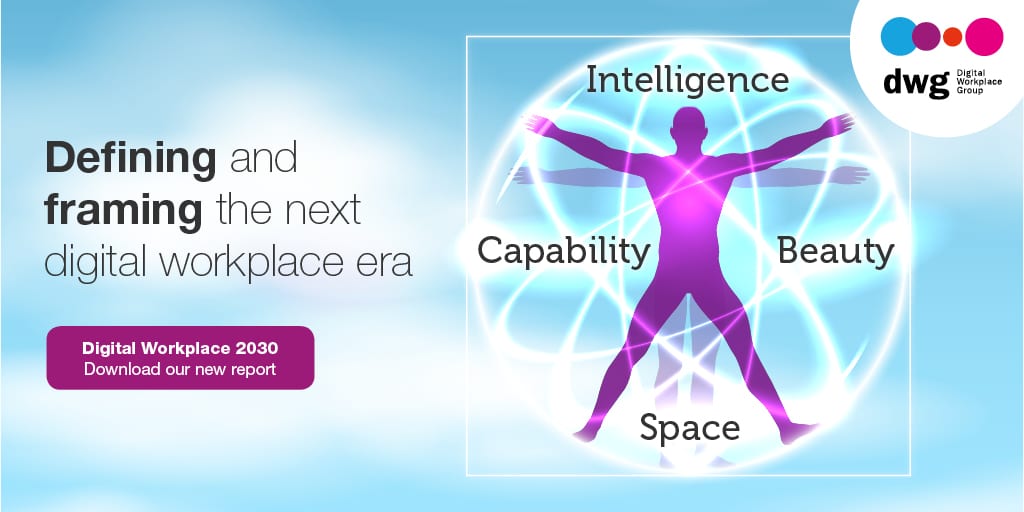Seven ways organizations can prepare for Digital Workplace 2030
June 12, 2019 Updated: July 11, 2022
 Back in April 2018, we set the scene for an exploration of the future digital world of work, and introduced the four dimensions by which we describe what the 2030 digital workplace might look like as set out in our research report: Digital Workplace 2030: Preparing now for the digital worlds of work to come. Here’s a quick reminder:
Back in April 2018, we set the scene for an exploration of the future digital world of work, and introduced the four dimensions by which we describe what the 2030 digital workplace might look like as set out in our research report: Digital Workplace 2030: Preparing now for the digital worlds of work to come. Here’s a quick reminder:Dimension 1: Space
Digital Workplace 2030 is characterized by its inclusiveness as it breaks down boundaries of organizations, teams and industries to enable digital and physical spaces for frictionless collaboration, creativity and innovation.Dimension 2: Capability
Digital Workplace 2030 is both immersive and pervasive, providing augmented workers and managers with on-demand capabilities tailored to their needs and preferences.Dimension 3: Intelligence
Digital Workplace 2030 is the intelligence engine that powers a data-driven, fluid organization, which shapes itself around the goals and needs of the market, the organization and its workforce.Dimension 4: Beauty
Digital Workplace 2030 is beautiful in its experience, ethical foundation and purpose of enabling human development, wellbeing and fulfilment at work. Looking ahead enables us to map out potential scenarios in order to help better guide our actions in the present. Analysis of what the “World’s Most Admired Companies” do differently has shown that they consistently focus on the long term, balancing the demands of the moment with future business needs. The changing nature of work is identified as a critical aspect of this long-term focus and planning. For digital workplace leaders asking what they should do now to prepare for the workplace of the coming decades, here are a number of recommendations and thinking points:1. Stay focused on strategy
New technologies arrive from the consumer space with no small amount of hype; so, digital workplace practitioners should be ready with a robust digital workplace strategy focused on business goals and employee needs. This enables experimentation and adoption of new tools to be driven by needs rather than the latest “shiny new thing”. The strategy should include a clear approach and criteria for evaluating and integrating emerging technologies. The four dimensions of Digital Workplace 2030 can be used to assess plans and progress against likely future developments. Mapping out future scenarios will need to involve a cross-organizational group so that the potential of emerging technologies can be understood in concert with, for example, an increasingly fluid workforce and more agile approach to real estate.2. Head off concerns
The technologies that promise to dominate the future digital workplace come with a host of concerns relating to risk, security, privacy, confidentiality, regulations, etc. Digital workplace practitioners need to open the dialogue early on, seeking input from areas such as risk and compliance, in order to avoid progress being hampered further down the road. Doing so will ensure that concerns are properly considered and addressed, and demonstrate to key stakeholders that due diligence is being done. This dialogue should extend to the ethical questions highlighted in this report, with a cross-organizational group needed to discuss and understand the issues and recommend an approach. Although some of these questions may seem far off at this point, the sooner organizations can gain clarity on the implications, the better prepared they will be as new capabilities continue to arrive apace.3. Start to experiment
While large-scale implementations of, for instance, cognitive computing systems or augmented reality applications may be some way off, organizations are already starting to experiment with these technologies. Oxford Economics found that many organizations expect emerging technologies to become investment priorities in 3 years’ time, including: big data/analytics (34%), Internet of Things (36%), 3D printing (28%), augmented/virtual reality (19%), AI/machine learning (30%), and robotics (27%).47 Developing proof-of-concept examples is critical to get beyond the hype of emerging technologies and to understand how they can be integrated into business goals and processes. This may involve identifying areas of the organization with a particular need that can be met by these tools and which demonstrate readiness to adopt them. It is important to define metrics for such experiments so that effectiveness can be assessed and measurable wins demonstrated.4. Understand employees
The promise of emerging technologies for digital work can only be truly realized if based on a thorough understanding of how employees work on a day-to-day basis in different roles and parts of the organization. Grounding conversations about future scenarios and capabilities in user personas validated through research will help to ensure that experiments are focused on real needs. As organizations map out what the composition and capabilities of the future workforce should be, personas can help to bring to life future needs and use cases. As the workforce becomes increasingly multi-generational, a critical aspect of this will be understanding the needs, motivation and attitudes of different generations of employees in relation to the digital workplace, and managing their expectations.5. Focus on skills
As emerging technologies progressively make their presence felt inside the enterprise, organizations will need to continue to raise their digital IQ. As well as involving the range of skills (e.g. operational, critical, creative) needed to use the technology as intended and with a degree of cognitive ease in order to be productive, this also means placing the emphasis on skills and traits that increasingly smart systems cannot replicate. For instance, emotional intelligence, critical thinking, adaptability, creativity and curiosity should all be nurtured within the workforce. At the leadership level this means helping current leaders to grow their digital skills and shift to new mindsets, as well as preparing a pipeline of future leaders with the capabilities that will be required in Digital Workplace 2030.6. Consider the cultural shift
Learnings from technological shifts in the last decade, such as around mobile and social media, will provide digital workplace leaders with rich insights into the importance of cultural context and change management for successful adoption of emerging technologies. However, if these lessons have not been taken on board, challenges relating to employee acceptance or resistance to new tools could escalate as they have an increasingly deep impact on the nature of work and jobs. Shaping and fostering a culture that is conducive to the adoption of tools such as personal digital assistants and chatbots should be a critical focus for leaders at all levels of the organization.7. Tell a story
Digital workplace leaders, as well as those in areas such as HR and real estate, need to weave a compelling and convincing narrative around the changing nature of both the physical and digital workplaces. This needs to emphasize a future in which humans work ever more closely with machines, rather than one which entails a battle between humans and machines. This needs to be a two-way dialogue that enables leaders and employees to familiarize themselves with the opportunities and challenges relating to the future of work, as well as discuss and help determine how the organization approaches it. Stories of successful adoption of proof-of-concept experiments from early adopters will help to bring the narrative to life, making it real and tying it back to individual employees’ daily work lives. Download the free ‘Digital Workplace 2030: Preparing now for the digital worlds of work to come’ research report to gain an in-depth view of coming developments to the digital workplace. Find out how Digital Workplace Group can help your organization prepare for the future digital workplace with our Digital Workplace 2030 workshop in which we take participants on a journey of ‘futuring’ and ‘visioning’. This challenging and thought-provoking session is designed to help digital workplace practitioners extend their thinking, identify potential future outcomes/opportunities/threats, and develop a vision for the future and how to move towards it.TAKE THE NEXT STEP
Categorised in: Digital workplace, Future of work, Research reports


